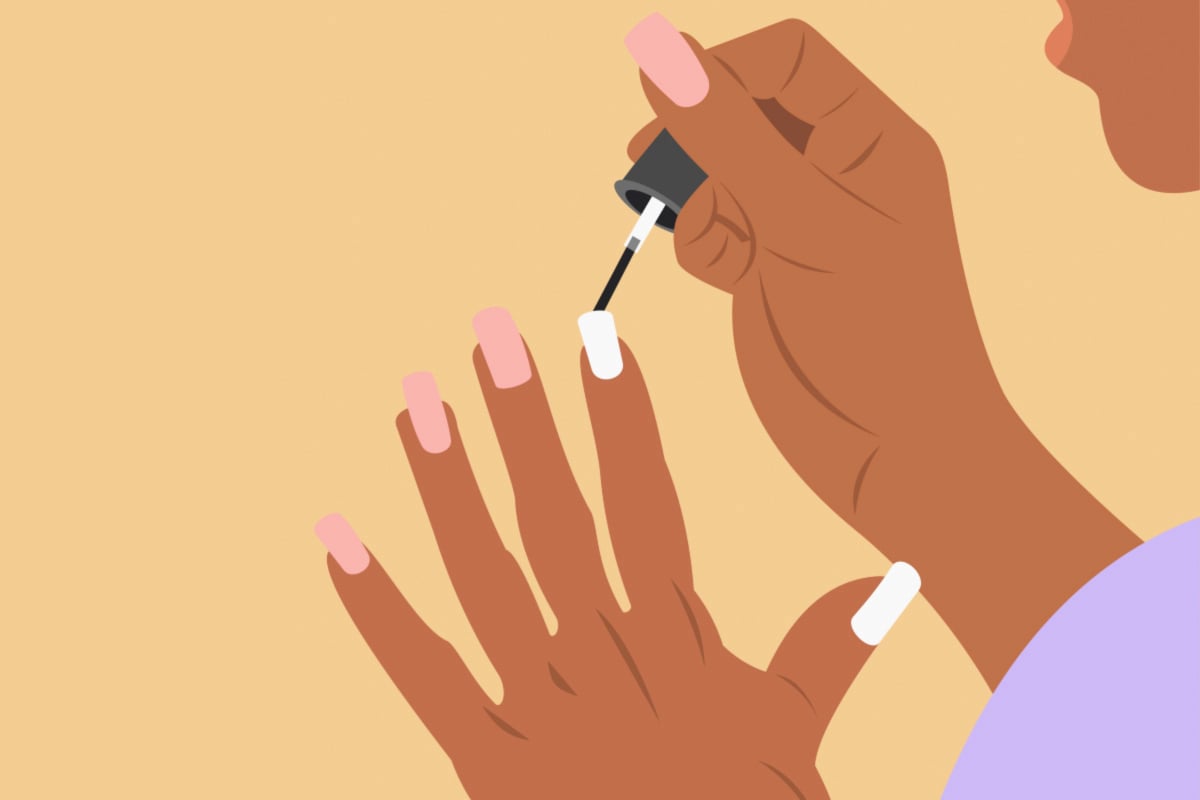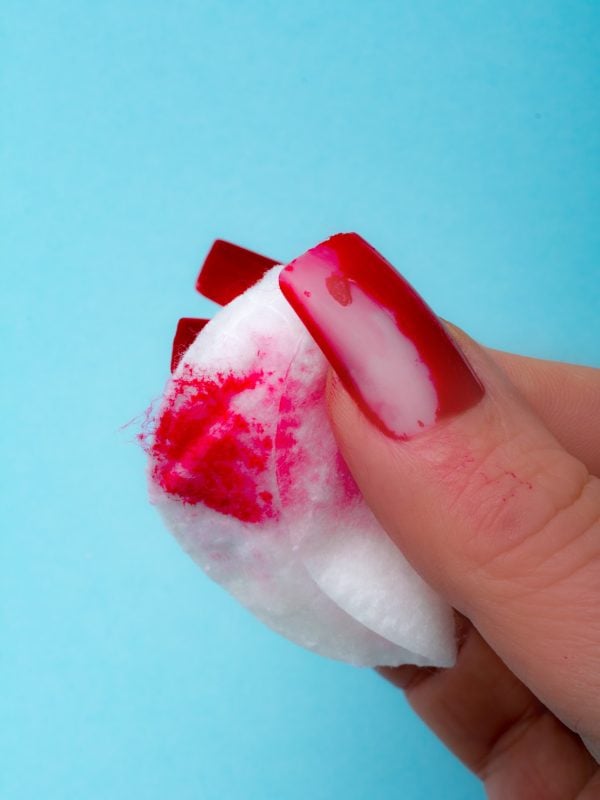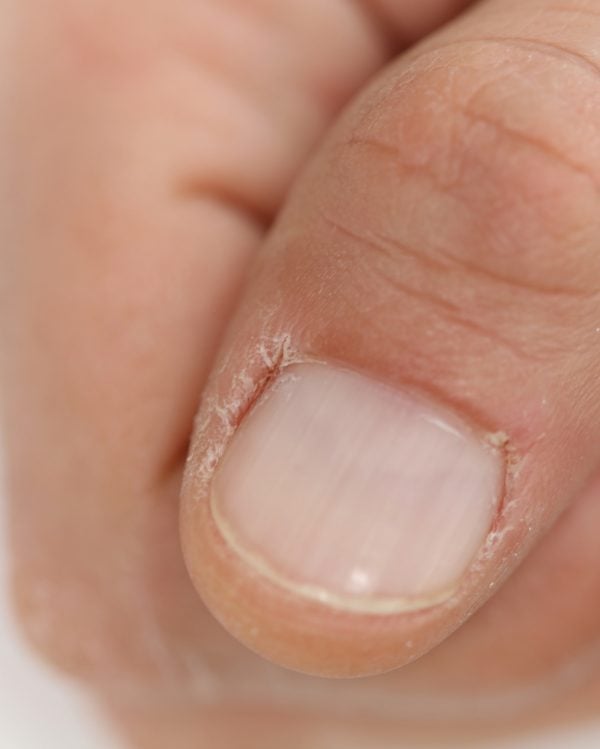What Is Finger Nail Polish Remover Made Of

For some, acetone blast polish remover is the big bad wolf of the boom industry.
You know. The bottles of stringent-smelling liquid you soak cotton wool wool balls in to remove that red toenail shine you've been painting over for 6,876,980 years.
Google 'is acetone bad' and you lot'll find lots of articles talking near the damage acetone shine removers can exercise to your nails, simply when y'all ask the experts, they'll tell you lot there's no hard science proving acetone smash smooth remover is dangerous.
But what really is acetone, what does information technology do to your nails and is it safe to use? And if acetone is 'bad', are there other ways to remove blast polish, acrylic nails, SNS nails and shellac without information technology?
To find out, we asked a dermatologist specialising in nail health, and ii nail technicians to explain what the fuss is around acetone and if it's fine to keep using it.
Before we get into it, here's a (hilarious) glimpse of what life is like with and without nails. Post continues subsequently video.
What is acetone and is information technology bad for nails? A summary…
- Acetone is a solvent that can be found in nail polish removers.
- Acetone polish remover works by breaking down nail shine and removing it from the blast plate surface.
- Acetone isn't toxic, but information technology is dangerous when ingested.
- Exposure to acetone can dehydrate the boom plate, cuticles and the surrounding skin – nails tin become dry and breakable, and cuticles tin can become dry, flaky, cherry and irritated.
- Non-acetone nail polish removers also comprise chemicals and natural nail polish removers crave scrubbing to remove polish, which tin harm the nails.
- Non-acetone solvent solutions can exist used to remove acrylic, gel, shellac and SNS manicures.
- There is no conclusive research to suggest acetone is harmful or toxic – it is the most effective nail polish remover currently on the market.
- Infections from poor salon hygiene, allergic contact dermatitis and UV lamps are all more than concerning nail problems than acetone boom polish remover.
What is acetone/what is acetone polish remover?
"Acetone, besides known as propanone, is a colourless, flammable liquid. It's a solvent (dissolves substances) and is used in the manufacturing of plastics, household products, cosmetic and personal care products," Sinclair Dermatology's Dr Samantha Eisman told Mamamia.
"Acetone is also produced in the homo body and is usually present in the blood and urine, as a by-product of metabolism."
The Nail Lab Blast Technician Thea Phan added, "In the dazzler industry, acetone is great for removing nail polish, gel colour and acrylic nails, and prepping the nail for a new coat of nail polish. Salons normally use a 70- 90 per cent acetone solution during manicures."
How does acetone in polish remover work?
Traditional smash smoothen removers are made up of an acetone solvent and a fatty material like lanolin or caster oil. Acetone removes shine by chop-chop breaking apart the boom varnish and stripping the polish from the nail plate surface.

Is acetone toxic?
Short answer, no.
"Acetone is not registered as a carcinogen (cancer-causing) and is thought to have low toxicity. The FDA (United states of america nutrient and drug administration) has accounted acetone safe in adhesives and food contact coatings. There are no disquisitional wellness effects from exposure to occasional or intermittent use of products containing acetone. The primary chief reason of concern is ingestion of acetone (and acetone-free removers) accidentally in children," Dr Eisman said.
What does acetone exercise to nails?
It's complicated.
Anything you exercise to your nails other than trimming and buffing them will cause some kind of damage, only both Dr Eisman and Phan agreed the biggest concern with using acetone for smash polish, gel, SNS and acrylic removal is dehydration.
"Blast enamel remover containing acetone can cause blast dryness or brittleness. It can too cause troublesome irritant contact dermatitis (carmine, dry, itchy, inflamed) of the skin surrounding the nail, which can cause pain and discomfort. Broken peel tin likewise be a portal for infection," Dr Eisman said.
Phan added, "People often don't realise the harm nosotros practise to our nails is not from the polish, but rather the remover. Acetone exposure can cause your nails, cuticles and the peel effectually your nails to go red, dry and flaky. Acetone has a huge effect on the cuticle skin, which is a protector of your nail. Cuticle skin will dry out when exposed to acetone (smashing, peeling, bleeding)."
Using acetone to remove gel, SNS and shellac manicures is a whole other brawl game.
"Gel, SNS and shellac are strongly adherent to the blast plate so they crave soaking the finger tips in acetone (or other solvents) for 10-15 minutes to remove. This prolonged exposure to acetone has been associated with nail splitting (onychoschizia) and white discolouration of the nails (pseudo-leukonychia). It can also exist associated with overall thinning and astringent brittleness of the nails. After soaking in acetone, the skin of the fingertips is also afflicted and will immediately look white, due to the fact the skin has dried out," Dr Eisman said.

The argument for using acetone to remove nail smooth.
Certain, acetone isn't the purest of solutions going around, but it's also non the biggest business concern in the nail cosmetics industry.
As Dr Eisman explained, there are other nail/manicure practices to exist more worried most, like infections from poor salon hygiene, allergic contact dermatitis to acrylates in nail cosmetics and UV lamps.
Acetone is also the well-nigh recognised type of boom polish remover and it'due south of import to annotation, both acetone and acetone-gratis removers contain chemicals.
"More than recently, acetone-gratuitous liquids have been commercialised. This distinction makes some people believe acetone is toxic, but there is no scientific evidence that says acetone is more dangerous than alternative acetone-gratis solvents. The cardinal ingredient in non-acetone removers is usually a less aggressive and less effective solvent like ethyl acetate fabricated from ethanol and acetic acrid," Dr Eisman said.
"In that location are many removers on the marketplace that avowal beingness fully 'natural' and biodegradable, but even smoothen removers that say 'natural' and 'organic' still incorporate solvents (just not acetone). They normally require more work and effort to remove nail polish and can therefore cause more trauma to the adjacent skin."
Put merely:
- Acetone blast polish remover = fastest way to remove boom polish and best for glitter/thick/stubborn polishes.
- Non-acetone boom polish remover = more gentle way to remove smooth, but will accept a scrap longer.
- Natural smash smoothen removers = free from chemicals merely will require transmission scrubbing to remove polish, which can impairment the boom.
So if not acetone, what else?
How to remove boom polish without acetone.
There are a number of acetone-free nail polish removers out there, but as mentioned, they all contain a dissimilar chemic solvent.
Phan said The Nail Lab employ OPI Expert Touch Lacquer Remover to remove nail polish. This contains 15 per cent acetone, as well as grape seed oil, vitamin Due east and aloe vera.
How to remove acrylic nails without acetone.
Nail technician Vanessa Schirripa of Pretty Piffling Things Beauty said the culling to using acetone to remove acrylic nails is the traditional file and drill technique.
"A boom technician can use nail pliers to help lift the acrylic from the boom bed and utilize a drill to help scale down the thick acrylic rather than dissolving it. Still, this tin can be a semi-painful way of removing faux nails equally the drill tin can requite a slight burning sensation on the actual nail. Not for the faint hearted!" she told Mamamia.
Side note - we decode all the unlike types of salon manicures on this episode of You Beauty below. Post continues after audio.
How to remove Shellac without acetone.
"Shellac is much thinner than acrylic and tin be removed through a peel, drill or buff. Not-acetone products can exist used for successful removal, also," Schirripa said.
"All you need to do is soak a cotton ball in a non-acetone product and wrap it around the shellac polish. Embrace with foil and permit it soak through for 10 minutes. Then, file or drill off the shellac and you're done."
Side note - To help minimise damage, use a nail strengthening product in betwixt every few manicures to keep your nails in skillful shape.
How to remove SNS nails without acetone.
Schirripa said SNS nails tin also be removed with a like not-acetone soaking process, but as SNS is thicker than shellac, it'll accept a bit longer.
"To remove SNS, soak the nails in an acetone-free remover for 30 minutes or until the gel starts to melt abroad. Once you experience the blast loosen, gently pull it off with tweezers. And so, you can file, shape and add together a articulate shine or smash strengthener," Schirripa said.
A last word on acetone and nail health...
After all that, here are Dr Eisman's final thoughts:
"Acetone is still the most effective and to the lowest degree traumatic way to remove nail varnish and does non at this stage announced to be toxic or have health risks. Whatever agent you chose, acetone or acetone-free, make sure to moisturise your hands and nails after polish removal."
Appreciate?
Desire more helpful content on nails? You lot can read more here:
- The surprisingly subtle leopard impress nail trend we can't end staring at.
- How to remove acrylic nails at home – it'due south easier than you recall.
- What are SNS nails exactly? An explainer.
- Wedding nails 101: Exactly how to get your nails ready for your wedding day.
- If your go-to manicurist does whatever of these 4 things, detect a new i.
- Everything y'all need to know about fiberglass nails, including all the pros and cons.
- Alarm: At that place's a safer and quicker non UV-lite alternative for your gel manicure.
What Is Finger Nail Polish Remover Made Of,
Source: https://www.mamamia.com.au/what-is-acetone-nail-polish-remover/#:~:text=Traditional%20nail%20polish%20removers%20are,from%20the%20nail%20plate%20surface.
Posted by: alvaradobely1954.blogspot.com


0 Response to "What Is Finger Nail Polish Remover Made Of"
Post a Comment